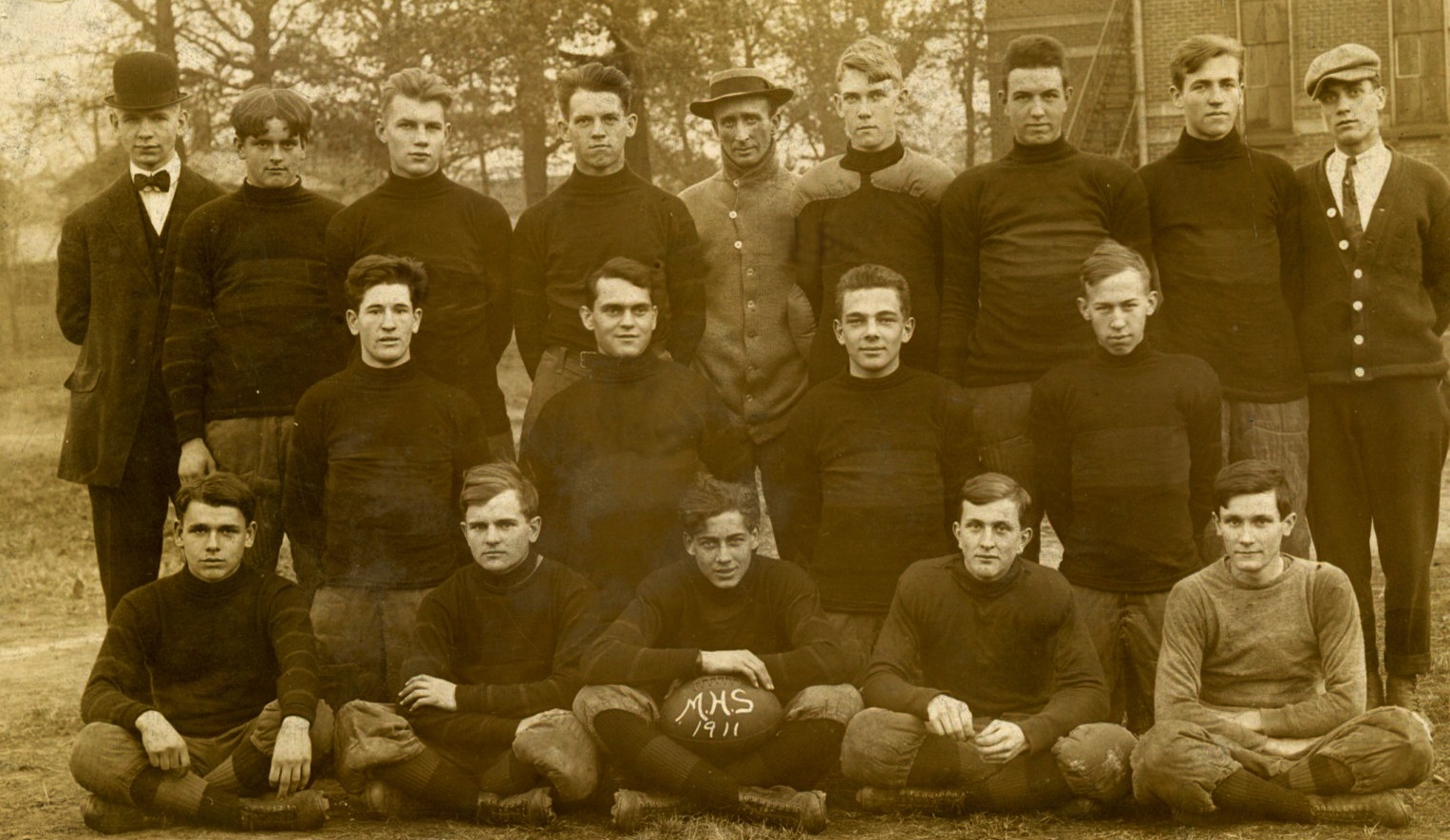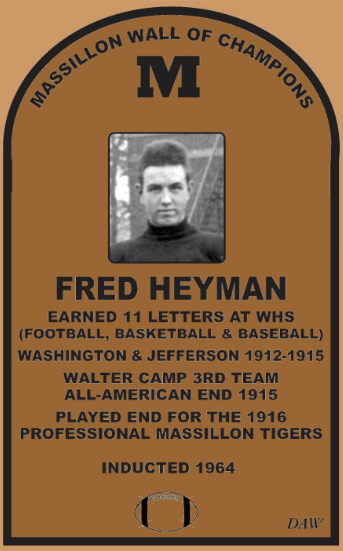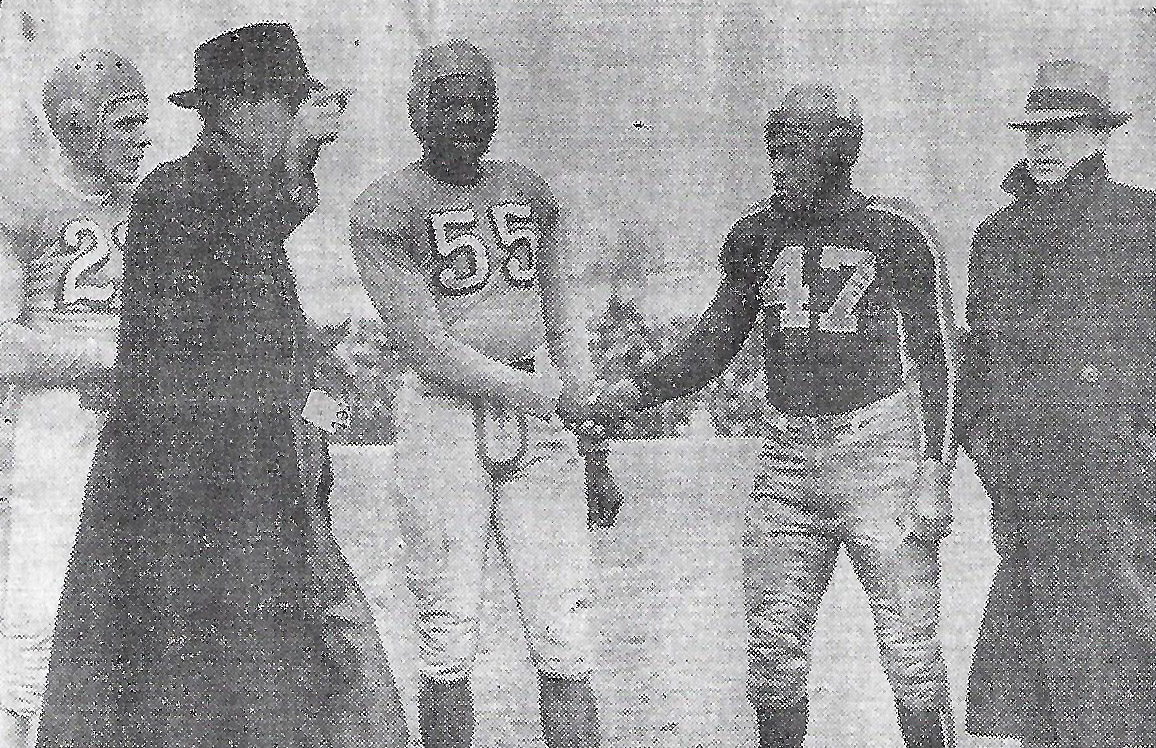
Fred Heyman – Wall of Champions
By James C. DeLong
One of the earliest heroes in the history of Massillon High School football was Fred Heyman, a four-year regular for the Tigers from 1908-1911.
Fred attended old Whittier grade school, then located at 8th and State Avenue, Northeast, before enrolling at Massillon High in the fall of 1908 as a freshman. The high school was then situated on the present site of Longfellow Junior High School.

1911 Massillon Tiger squad. Fred Heyman is pictured in the top row, third from the right.
Heyman immediately made the Tiger starting eleven, but because of his size, 145 pounds, he was placed at left guard. He recently remarked, “that in those days, the smallest men on the squad were automatically placed at guard.”
Fred’s career at guard for the Tigers lasted just during the 1908 campaign and he was then shifted to right halfback in 1909 and remained there for the next three years. He added weight during his last three during his last three years and as a senior played at 190 pounds.
As a halfback, Fred was described as a slashing runner and he carried the brunt of the Tigers running attack for three years. During his senior year, he led the Tiger team in scoring with 10 touchdowns, 23 points after touchdown and one field goal for 85 points. In 1911, a touchdown was only good for 5 points. Nine of Heyman’s extra points came by drop kick.
During his entire career here, Fred was a two-way player. On defense, he also played at halfback. As a punter he had no peer and did all of the Massillon kicking for four years.
Fred has the distinction of playing on the first Massillon team to defeat old Canton Central High
school, the forerunner of Canton McKinley. In 1908, the Tigers edged the Bulldogs, 12-6, in the second game played with Canton that year, marking the first win over the Cantonians in the series which originated in 1894. In 1909, the Tigers defeated Canton in both games and then the series was temporarily suspended during the remainder of Heyman’s career because of the intense feelings existing among the fans.
The Tiger home games during this period were played on the site of the present Longfellow junior High School practice field. About 300 fans would jam their way around the field to watch the Tigers engage such traditional foes of the period as Akron Central, Alliance, Cleveland Shaw, Mansfield and New Philadelphia.
The 1909 Tiger team on which Heyman played as a sophomore, claimed the state scholastic title on the basis of nine wins and one tie. The tie was a scoreless duel with Akron Central, then the only public high school in the Rubber City. The big victory came in the final game of the season, when the Tigers defeated powerful New Philadelphia, 21-5. The Tiger citizens were so pleased with the local high school eleven that they purchased turtle-necked monogramed sweaters for all members of the team.
After graduation from Massillon High, Fred enrolled at Washington & Jefferson College, then one of the powers of the intercollegiate football. He played four years at W & J – 1912-15 and was the regular left end during his final three years. All told, he won nine letters at W & J in football, basketball and baseball. The high point of his career came after the 1915 campaign, when the late Walter Camp named him to his Third Team All-American eleven as an end.
In 1916, Fred became head football coach and athletic director at Bethany College (2-7 record) and on Sundays came to Massillon to play with the Massillon pro football Tigers. He teamed up at the ends with the late Knute Rockne on this Tiger team.
Due to mustard gas complications received in World War I, Fred has been retired since 1928. He resides with his wife, Mae, at 430 – 11th Street, Northeast, Massillon.
Story Supplement
In 1910 Heyman scored two touchdowns and kicked five extra points. He was a regular at halfback in 1911 and scored 10 touchdowns. He also punted, kicked off and kicked 21 extra points (10 vs. Urichsville) and 2 field goals, utilizing the drop-kick technique, including one in a 3-0 victory over Alliance. His coach during his final three years was Ralph “Hap” Fugate.
“I often wonder how far we would have gone if we had it as good as the high school boys today,” said Heyman. “We didn’t have a paid coach, but Ralph Fugate used to come up to practice after work and give us a lot of pointers. Our uniforms were hand-me-downs and if we wanted the field lined for the game, we went down in the morning and lined it ourselves.”
Heyman earned eleven letters at Massillon, in football basketball and baseball. He subsequently received an offer to play professional baseball from Newark of the International League. But he turned it down in favor of receiving a college education. There, at Washington & Jefferson, he won three letters in football, four in baseball and two in basketball (there was no basketball at W&J in his first two years). Interestingly, the forward pass was a regular part of the W&J offense (see Stanfield Wells story).
As coach of Bethany, Heyman’s team played on Saturday afternoon. Following the game, Heyman would head straight for a train, riding all night to play for the Tigers pro team. Rockne would do the same thing, for a fee of $150. Neither would practice in the days leading up to a game.
With the onset of World War I, Heyman enlisted in the military in 1917 and served time in the European theater. Unfortunately, he was overcome by mustard gas while in the Argonne forest, having taken off his mask, which had clouded his vision. That spelled the end of his athletic playing career.
After football, he sold real estate. He was also a past commander of the Massillon American Legion and led the Legion’s Drum and Bugle Corps to a state title in 1933. He died in 1973.
In 1964 Heyman was inducted into the Massillon Wall of Champions.


